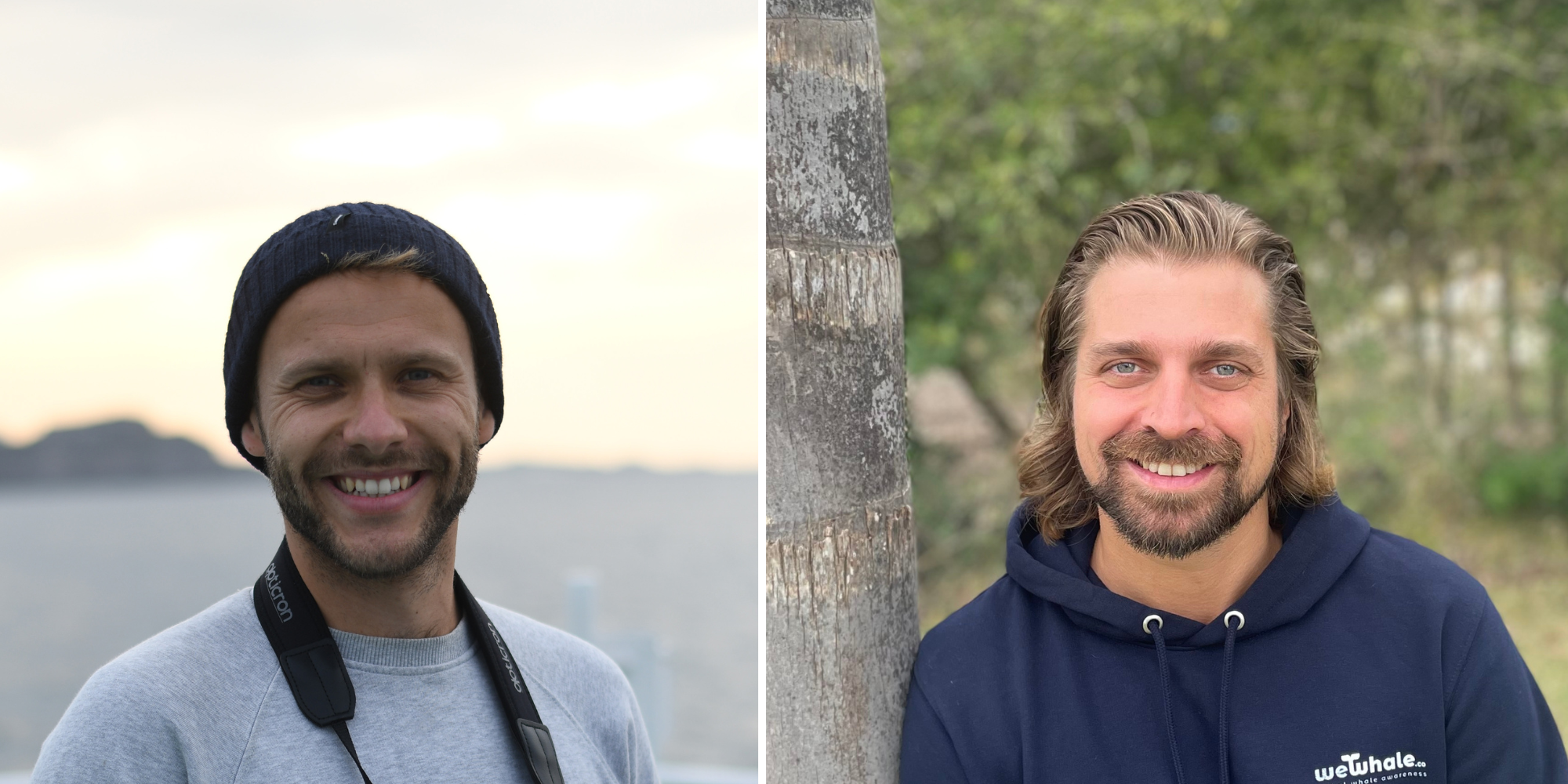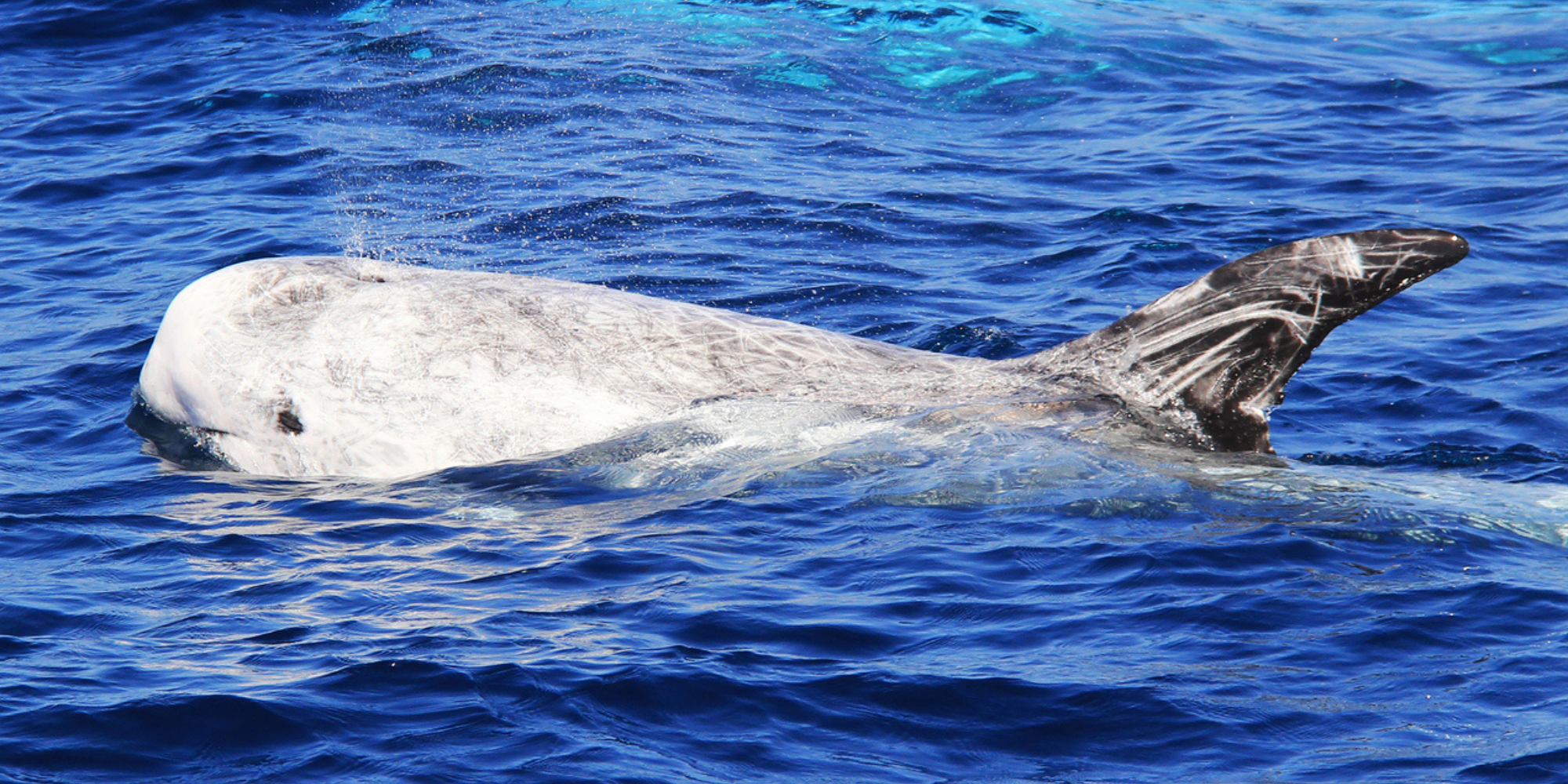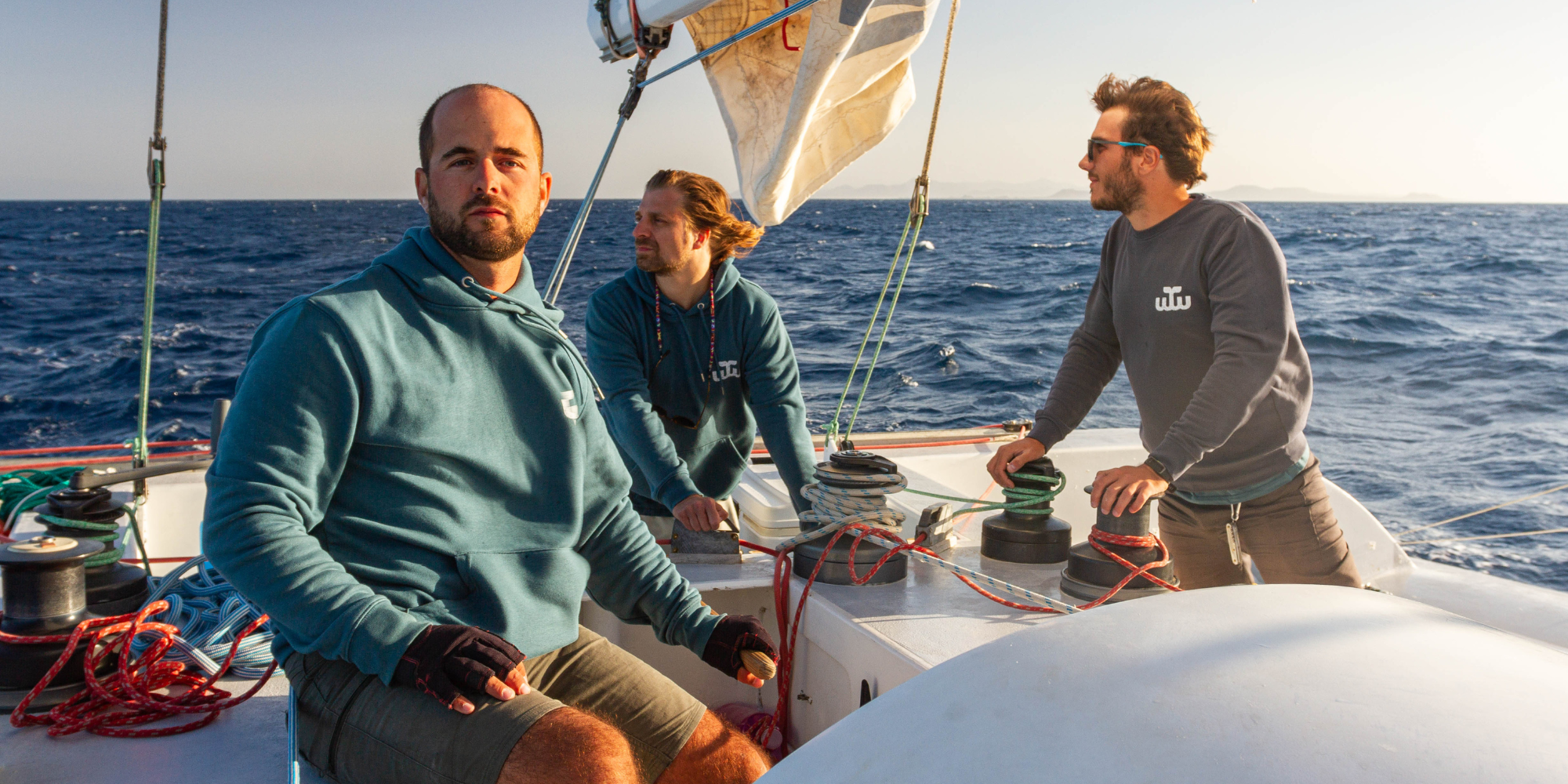The WeWhale Pod Episode 11 - Billy Heaney
Our guest for this episode of The WeWhale Pod is Billy Heaney, zoologist, wildlife presenter and filmmaker.
Billy talks about his path to becoming a zoologist, his time spent researching grey seals in Cornwall, and his film ‘In Search of the Killer Whale’ which captures a pretty spontaneous trip he and two friends made to see orcas in the wild in Iceland.
He also chats about his work with Whale and Dolphin Conservation’s campaign ‘EndCaptivityForever’. While dolphinariums have been closed in the UK since 1993, they aren’t actually illegal in the country. The campaign seeks to make them illegal, meaning they can never happen again.
Billy also talks about ending whaling and the need for more ocean sanctuaries for whales and dolphins.
Take a listen to the episode below:
You can find out more about Billy’s work on his website and Instagram.
Thanks to Skalaa Music for post-production.
You can listen to previous episodes on our Podcast Page.
WeWhale launches short documentary, The Future of Whale Watching
WeWhale is proud to launch its short documentary, The Future of Whale Watching, which features the work that the organisation is engaged in and outlines its vision for the whale watching sector. The film also includes some stunning whale and dolphin footage captured from WeWhale’s boats in Lanzarote and Tenerife (including underwater footage).
WeWhale’s mission is to make the world a noise and emission-free whale and dolphin watching place, where animals can thrive, and humans can learn. The organisation believes that the only way to offer animal and eco-friendly observation tours is to remodel vessels to become silent and CO2 neutral boats.
The documentary, made by filmmakers Ricardo Neiva and João Matos, explains how WeWhale came about, in the words of its founder, Janek Andre:
“Whale watching has been around for 70 years and there hasn’t been much innovation. There are more than 3,000 boats around doing whale watching worldwide at the moment. They still use old engines, old boats and ferry style tours.
“Diesel and petrol engine systems are creating a lot of noise but also leave a lot of lubricants in the water, in the ocean. So they basically not just create a lot of noise pollution but also environmental pollution.
“So the idea is we refit our boats to hybrid ones or 100% electric ones, to have this threat for the animals taken out. By remodelling boats to silent ones, using electric power, using wind power, using solar power, so that we are clean and 100% animal friendly.”
WeWhale boats are equipped with hydrophones and 360 degree cameras so that guests on board have a full and enriching experience. The WeWhale team is motivated to take guests out into the ocean in small groups, explaining about the ocean, the importance of its inhabitants, and bringing greater understanding to the world of whales and dolphins.
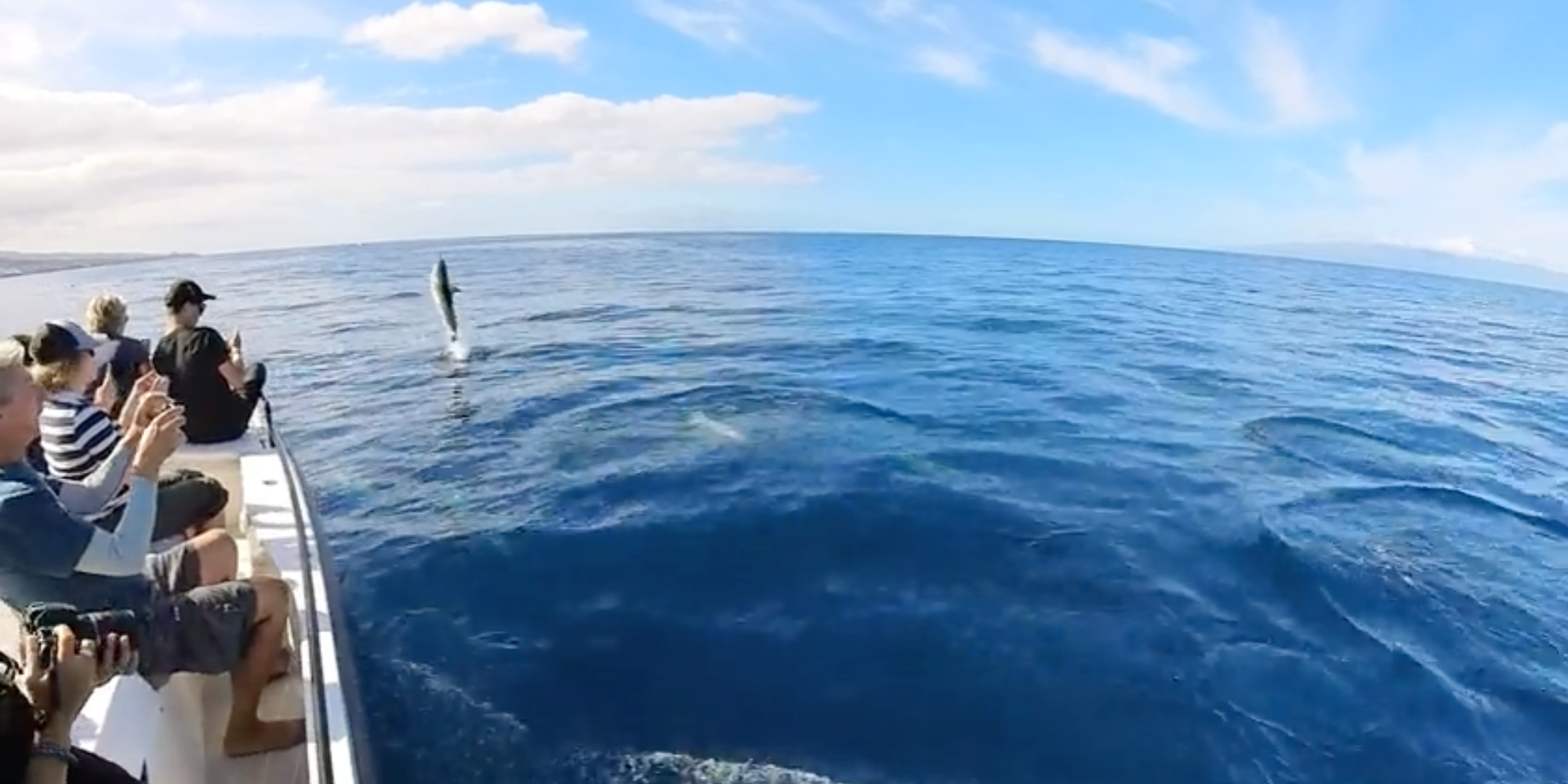
The documentary also features other members of the WeWhale team, including Mercedes Reyes, Director of WeWhale Tenerife and Head of Conservation at the organisation.
Mercedes talks about how her interest in whale and dolphin conservation was sparked by a special encounter with a white dolphin when she was a young girl. Ever since then, she’s been curious to learn all she can about cetaceans and to do as much as possible to help with their long-term protection.
The documentary also discusses how important it is for people to choose companies that practise responsible and respectful whale watching.
Along with the people featured in the documentary are the real stars of the show, the whales and dolphins! The many species, filmed from the WeWhale fleet in Lanzarote and Tenerife, include false orcas, rough-toothed dolphins, short-finned pilot whales, Atlantic spotted dolphins, bottlenose dolphins, common dolphins and Bryde’s whales.
Founder Janek Andre said of the documentary, “We’re really thrilled at WeWhale to share this short film with everyone so they can see the work that we’re doing and get involved in the discussion about the future of whale watching.
“We’re at a crucial crossroads in terms of environmental protection and wildlife conservation so it’s a very good time to focus on how responsible whale watching can actively contribute to this.”
The Future of Whale Watching documentary will be added to over the coming year as WeWhale launches new whale watching locations in Europe. The documentary can be viewed on the WeWhale YouTube page and also on the WeWhale website.
New website for WeWhale Association is launched
We’re delighted to launch a new website for WeWhale Association, the sister organisation of WeWhale.co. The website – at www.wewhale.org – showcases the many projects that are being undertaken with the mission of creating awareness and protection for the cetaceans of the world.
These projects are:
End Irresponsible Whale and Dolphin Watching Practices
Irresponsible whale and dolphin watching practices harm cetaceans and their environment. We expose companies not following regulations and we aim to create awareness amongst people so they can recognise irresponsible practices.
Attacks Against Orcas
A vital initiative dedicated to raise awareness about aggressions against the critically endangered Iberian Orca population. We aim to prevent acts of harassment and on receiving reports of harassment or crimes against orcas, we work on legal prosecution.
Stop Whaling
WeWhale Association is a member of the International Whaling Commission as an NGO observer. The last meeting was held in 2022 in Portoroz, Slovenia.
End Captivity
WeWhale Association actively participates as a leading member in a European sanctuary dedicated to reintegrating captive dolphins and whales within the EU. This initiative is designed to transition these marine mammals from captivity back to their natural environments in a responsible and ethical manner.
End Ship Strikes and Animal Injuries
In addition to the technical development of a ship strike prevention system, we expose vessels that do not adhere to local regulations to prevent collisions, thus contributing to the death toll of whales and dolphins.
More information on each of the projects and how people can help support them is available on the website.
President of the WeWhale Association, Janek Andre, said, “We’re excited to have a brand new website that highlights our projects and initiatives to a wide audience. Our work is defined by projects that discover, expose, and prosecute wildlife crimes against whales and dolphins, as well as raising awareness among the public and local communities in areas where whales and dolphins play a vital role in the ecosystem.”
Check out www.wewhale.org for more information.
Deep dive...into Beluga whales
One of the smallest species of whale, the beluga whale belongs to the family Monodontidae, along with the narwhal.
Weighing in at up to 1.5 tonnes and measuring between four and six metres in length, the beluga is also known as the white whale. It begins life as a dark grey calf but its skin lightens as it ages, becoming white when the animal reaches physical maturity.
Its white skin helps the beluga to camouflage itself in the Arctic and sub-Arctic regions where it’s found. The beluga whale is recognisable by the melon on its top of its head which helps to focus and modulate its vocalisations. Belugas are known as the ‘canaries of the sea’ because of the wide range of communication sounds they use, including clucks, mews, chirps, trills, whistles and squeals.
The melon on its head can change shape while it makes sounds. This, along with the flexibility that the beluga has in its neck vertebrae, means the animal can make facial expressions and move its head side to side. These actions often come across as endearing to humans (a reason it was so heavily targeted by the captive animal industry).
The beluga’s scientific name is Delphinapterus leucas which translates to ‘dolphin without a fin’. Instead of a dorsal fin, the beluga has a tough dorsal ridge which helps it to easily swim under ice floes.
But don’t get confused by its scientific name, the beluga is most definitely a whale, belonging to the toothed whale group. The species has 18 to 20 teeth in both its upper and lower jawbones.
The beluga has a thick layer of blubber, which makes up to 40 per cent of its weight. It also has a thick layer of skin. Both of these are needed to keep it warm in the cold Arctic waters.
Belugas are very social animals, coming together in pods to migrate, hunt and interact with others. They’re also naturally curious, often approaching boats and divers, and naturally smart. This means they can easily be trained, which has been exploited by marine parks, zoos and even by the U.S. and Russian naval forces.
Check out this New York Times article about navies training dolphins and whales.
The average life span of a beluga whale in the wild is 35 to 50 years.
Where do beluga whales live?
Belugas live all around the sea ice in the Arctic and sub-Arctic. The regions include Russia, Canada, Greenland and Alaska. Most populations migrate as the sea ice changes in the Arctic – as ice forms in the autumn, they move south and then return again in the spring when the ice breaks up.
However, even during the winter, they’re fine with swimming around thin ice, which they can break through to breathe. Belugas are often found along coastal bays and inlets and are equally comfortable in freshwater and saltwater.
Some populations have become resident in areas, including the Cook Inlet in Alaska where they are recognised as ‘critically endangered’.
Occasionally, belugas have gone off track in their navigation. In 2018, one was spotted in the River Thames in London but fortunately it returned later to the sea. Find out more about the individual who was given the name Benny the Beluga.
In 2022, another beluga made its way up the River Seine in Paris. It was successfully rescued to be transported to the sea but sadly had to be euthanised when it became unwell and couldn’t breathe. Read more in this BBC article.
Population
The beluga whale is listed as ‘Least Concern’ globally on the IUCN Red List of Threatened Species, though it is defined as endangered or depleted in specific regions of the world e.g. Cook Inlet in Alaska, Sakhalin-Bay-Nikolaya Bay-Amur River in Russia.
Globally, the beluga whale population is estimated to be 136,000.
What do they eat?
Beluga whales eat a wide variety of fish and shellfish species including salmon, herring, cod, octopus, squid, smelt, flatfish, crabs, shrimp and molluscs. They’re also known to eat snails and sandworms.
The species relies on its hearing and its ability to echolocate (using the melon) to hunt for prey. Belugas also have really good vision in and out of the water.
Threats to Beluga whales
Vessel strikes
Beluga whales are at risk of vessel strikes throughout their range but the threat is much higher in areas with busy ship traffic.
Environmental change and pollution
Climate change and pollution are a threat to all whales and dolphins because of the loss of habitat as waters become warmer.
As their life cycle and habitat is so closely connected to life in the Arctic circle, beluga whales are a species more affected globally by climate change and the melting of the polar caps. The effects include reduction in food sources and changes in migration patterns.
Plastics and micro plastics, along with chemical pollutants, entering into the water system are a serious threat to all creatures in our ocean.
Beluga whales, like other cetaceans, use noise to communicate and to locate prey. Increased noise pollution from vessels and other human activity interferes with this ability.
With their great blubber stores, research shows that belugas tend to accumulate more chemical contaminants in their bodies which affect their long-term health.
Entanglement in fishing gear
Like other cetaceans, beluga whales can become entangled in fishing gear which goes on to cause injury, fatigue, comprised feeding and sometimes even death.
Hunting
Belugas are hunted by polar bears and orcas, being more vulnerable if they get trapped under the Arctic ice. The whales are also hunted by indigenous people of the north. Thankfully commercial hunting of beluga whales is no longer permitted.
The WeWhale Pod Episode 10 - Dr Vanessa Pirotta
Our guest for this episode of The WeWhale Pod is Dr Vanessa Pirotta, wildlife scientist and science communicator.
Vanessa talks about how the film Free Willy inspired her (and a generation of marine scientists) to get involved in working with whales.
She also chats about the work she does with a citizen science marine programme in Australia and her fascinating research work focusing on whale snot and using drones.
The conversation also delves into southern right whales and Migaloo, the famous albino whale!
Take a listen to the episode below:
You can find out more about Vanessa’s work on her website and Instagram.
Thanks to Skalaa Music for post-production.
You can listen to previous episodes on our Podcast Page.
Deep dive...into Risso's dolphins
Tending to inhabit deep offshore waters, Risso’s dolphins are the fifth largest member of the family Delphinidae and are sometimes called ‘grey dolphins’.
As they prefer deep water, Risso’s dolphins are relatively understudied (there are several places around the world where they’re found near the coast which has enabled research carried out to date).
The cetacean is named after a French-Italian naturalist called Antoine Risso who first described the species to renowned naturalist George Curvier in 1812.
Risso’s dolphins have a bulbous head, no discernible beak, elongated flippers and a tall curved dorsal fin.
Their colouration changes over their lifetime from dark grey to light grey or even white (check out this recent Newsweek article on a completely white Risso’s dolphin spotted off the Californian coast). As a Risso’s dolphin ages, it becomes paler.
Due to their prominent dorsal fin, Risso’s dolphins sometimes get mistaken for orca or white sharks when they’re spotted mostly underwater.
The species measures up to four metres in length and weighs in at up to 500 kilograms.
One distinctive feature of the species is that they’ve much fewer teeth compared to other cetaceans – they have between two and seven pairs of teeth in their lower jaw and usually none in their upper jaw.
Risso’s dolphins are noticeably scarred, either with scratches caused from teeth raking between dolphins or circular markings from prey such as squid, cookie-cutter sharks and lampreys.
The scarring contributes to the colour changes experienced over their lifetime.
The species is very active on the ocean’s surface, often leaping out of the water, spy hopping and slapping the pectoral fins or fluke on the water’s surface. Risso’s dolphins typically avoid boats but have been observed bow riding on occasion.
They also sometimes ‘porpoise’ which means moving in and out of the water in a series of fast leaps (most often when they’re being hunted by predators). They regularly dive down to around 300-500 metres and can hold their breath for up to 30 minutes.
Risso’s dolphins are usually found in groups of between 10 and 30 animals though they can also be found individually or in pairs. There are documented superpods of Risso’s dolphins with hundreds of animals gathering together.
With an estimated lifespan of at least 35 years, the Risso’s dolphin is listed as ‘Least Concern’ globally on the IUCN Red List of Threatened Species.
Studies are currently being carried out into Risso’s dolphins off the Balearic Islands by the Alnitak Research Institute. In 2021, the species’ IUCN status in the region was changed from ‘Data Deficient’ to ‘Endangered’.
You can read more about the research in this Discover Wildlife article from June 2023.
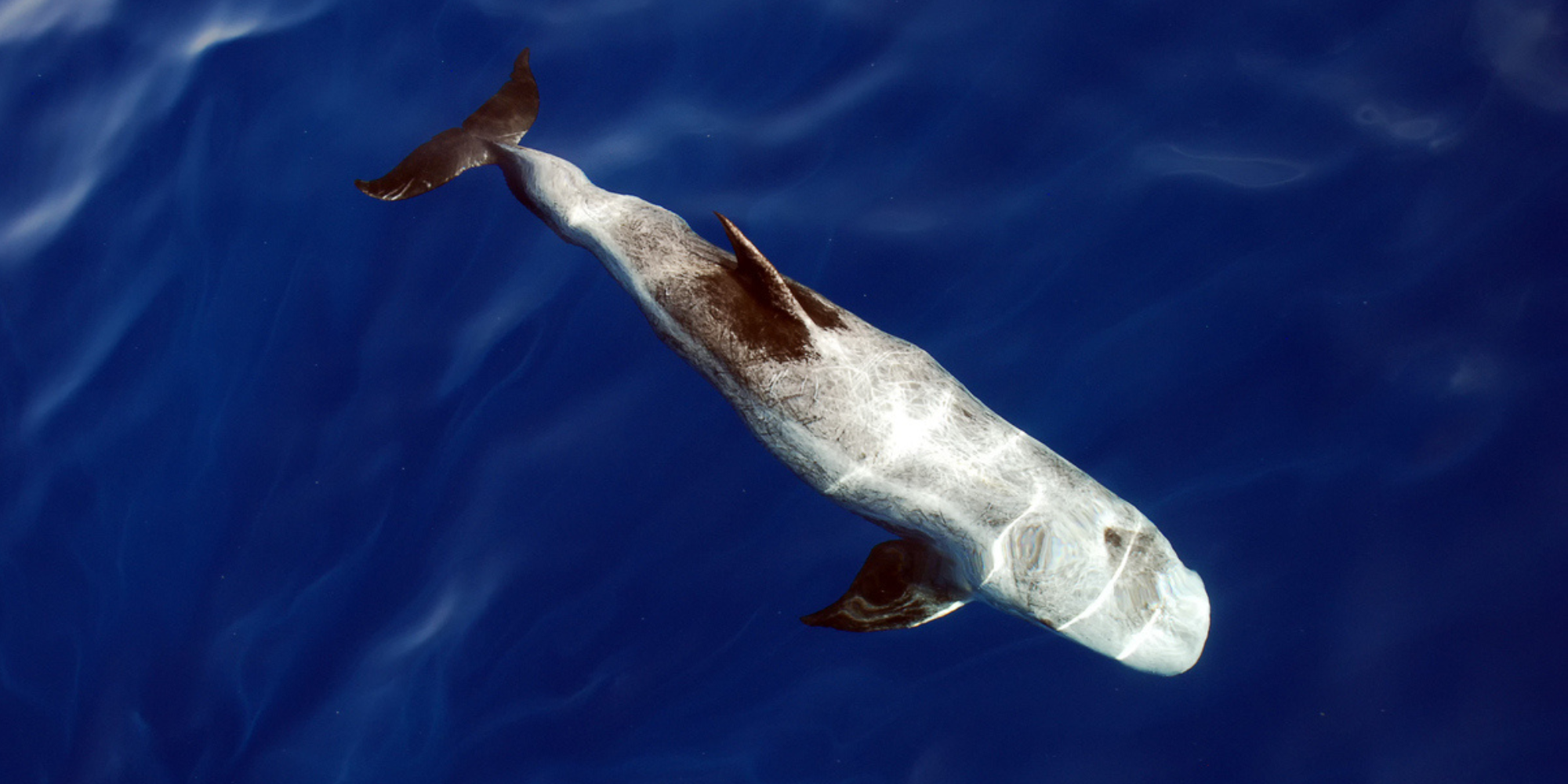
Where do Risso’s dolphins live?
The species is found worldwide in temperate, subtropical and tropical waters, preferring offshore waters (especially near the continental shelf edge). The dolphins are usually found in habitats from latitudes 64° North to 46° South.
In the Northern hemisphere, they’re found in regions including the Gulf of Alaska, Gulf of Mexico, Newfoundland, Norway, Japan, the Red Sea, Russia and the Azores.
They’re also found in the Mediterranean Sea, off the Canaries and are occasionally spotted off the UK and Irish coasts. In the Southern hemisphere, Risso’s dolphins are found in locations including Argentina, Chile, South Africa, New Zealand and Australia.
A Risso’s dolphin called Pelorus Jack became famous in New Zealand in the late 19th century. He was first noticed in 1888 awaiting boats near the entrance to Pelorus Sound, in the Marlborough Sounds, and he’d escort the ships travelling between Wellington and Nelson.
He often swam up against the boats and rode their bow waves.
Pelorus Jack did this for a long time – 24 years – and his fame grew with lots of people coming to see him. Read more about him in this Dolphin Project article.
What do they eat?
Risso’s dolphins love to eat squid but they’re also known to eat prawns, shrimp, cuttlefish, octopus and krill.
They mostly feed at night and usually suck in their food rather than biting it, which explains why they have relatively few teeth compared to other cetaceans.
Threats to Risso’s dolphins
Entanglement in fishing gear
Like other cetaceans, Risso’s dolphins can become entangled in fishing gear which goes on to cause injury, fatigue, comprised feeding and sometimes even death. Historically, Risso’s dolphins died in large numbers when they got caught up in purse seine nets along with tuna. Dolphin-safe tuna fishing practices have been implemented over the past few decades, helping to significantly reduce this impact.
Hunting
Risso’s dolphins are hunted for meat and oil off the coast of Japan (including the cove at Taiji) and several other countries around the world (Indonesia, the Lesser Antilles in the Caribbean, Sri Lanka and the Solomon Islands).
Environmental change and pollution
Climate change and pollution are a threat to all whales and dolphins because of the loss of habitat as waters become warmer.
Plastics and micro plastics, along with chemical pollutants, entering into the water system are a serious threat to all creatures in our ocean.
Risso’s dolphins, like other cetaceans, use noise to communicate and to locate prey. Increased noise pollution from vessels and other human activity interferes with this ability.
Natural predators
Orca have been observed preying on Risso’s dolphins and sharks are also predators of the species.
Deep dive…into Bryde’s whales
Bryde’s whales, which belong to the baleen whale family, are found in warm temperate, subtropical and tropical waters.
They’re considered one of the ‘great whales’ or rorquals, a group that also includes blue whales and humpback whales.
Bryde’s whales are named after Johan Bryde, a Norwegian who built the first whaling stations in South Africa in the early part of the 20th century.
The species looks very similar to sei whales but are smaller and also prefer warmer waters. They’re slender in appearance and their colouration is dark blue-grey with white bellies. Their heads make up about one quarter of their entire body length.
With three prominent ridges on the front of their blowhole, Brydes’ whales have slender and pointed flippers, a strongly hooked dorsal fin and a broad fluke (tail).
Like other baleen whales, Bryde’s whales have grooved pleats on each side of their mouths that sieve water from the food that they ingest.
You’ll most often spot the species alone or in pairs. More rarely, they are spotted in groups of up to 20 feeding together.
Weighing in at up to 20 tonnes, Bryde’s whales spend most of their day within 15 metres of the water’s surface and they usually swim at around 1.5 to 6 kilometres an hour, though they can increase speed to 20 kilometres per hour.
They’re well known for being able to change directions unexpectedly when swimming. Another distinctive behaviour is how they blow water up to three metres in the air.
The Bryde’s whale spends most of its time in the open ocean, away from the coast. They can dive to great depths to catch their favourite prey.
Where do Bryde’s whales live?
The species prefers waters of 16°c or more so they’re only found in tropical, subtropical and warm temperate waters. They are the only species of baleen whale that lives in these warmer waters. They’re spotted mostly between latitudes 40°N and 40°S.
Some Bryde’s whales are year-round inhabitants in their locations whilst others migrate seasonally from shallower coastal waters to deeper offshore waters.
In the Pacific Ocean, the species is found around Japan, Australia and New Zealand and in the Indian Ocean, the whales also found in Australia along with South Africa and southeast Asia.
They are also spotted in the Atlantic Ocean, from the Gulf of Mexico right across to West Africa (they’re a species that is often spotted in the Canaries), and they’re found off the coast of South America.
If you recall a news story from a few years ago about a man being caught up in the jaws of a whale and subsequently spat back out, it happened in South Africa and involved a Bryde’s whale. Find out more in this news article from The Guardian.

Population
Bryde’s whales are an understudied species and more research is needed on their migration patterns and population.
Due to the fact that Bryde’s whales and sei whales have (and still continue) to get confused for each other, it has made it difficult to estimate population numbers.
Bryde’s whales were not heavily targeted during the peak period of commercial whaling, mostly because their location was outside of common whaling grounds and also because they were smaller and had less blubber than other whale species. It’s thought, therefore, that their population numbers were not impacted to any significant degree by whaling.
On the IUCN Red List of Threatened Species, the Bryde’s whale is classified as of ‘Least Concern’.
What do they eat?
Bryde’s whales mostly eat schooling fish, which includes sardines, anchovies, mackerels and herring. They have also been documented eating krill, plankton, red crabs and shrimp.
They’re active lunge feeders, pushing through the water with an open mouth and throat pleats extended.
Only two species of whales have been observed using bubble nets to catch prey – humpback whales and Bryde’s whales.
Threats to Bryde’s whales
Vessel strikes
Bryde’s whales are at risk of vessel strikes throughout their range but the threat is much higher in areas with busy ship traffic.
They are the third most commonly reported species struck by vessels in the southern hemisphere.
Environmental change and pollution
Climate change and pollution are a threat to all whales and dolphins because of the loss of habitat as waters become warmer.
Plastics and micro plastics, along with chemical pollutants, entering into the water system are a serious threat to all creatures in our ocean.
Bryde’s whales, like other cetaceans, use noise to communicate and to locate prey. Increased noise pollution from vessels and other human activity interferes with this ability.
Entanglement in fishing gear
Like other cetaceans, Bryde’s whales can become entangled in fishing gear which goes on to cause injury, fatigue, comprised feeding and sometimes even death.
Hunting
In recent years, Bryde’s whales have been hunted off the coasts of Indonesia and the Philippines. A number of Bryde’s whale catches are carried out by Japan, which does so under the guise of its ‘scientific whale research programme’. See more in this IFAW article.
The WeWhale Pod Episode 9 - Finn van der Aar
Our guest for this episode of The WeWhale Pod is Finn van der Aar. She is a marine scientist, sustainability expert and bestselling author.
Finn tells us about growing up close to the ocean in Ireland, her love of surfing (including an epic experience when a bottlenose dolphin surfed alongside!) and why she thinks we connect so deeply with whales and dolphins.
She also talks to us about research into marine noise pollution and what can be done to reduce the noise, for the health and wellbeing of marine mammals.
Finn also fills us on her upcoming book, a novel that’s been informed by her real life experiences at sea.
Take a listen to the episode below:
You can find out more about Finn’s work on her website and Instagram.
Thanks to Skalaa Music for post-production.
You can listen to previous episodes on our Podcast Page.
WeWhale launches merchandise collection, with 100% of the profits going directly to whale and dolphin protection projects
WeWhale is thrilled to announce the launch of its new merchandise line which will directly help whale and dolphin protection projects.
The merchandise is now available on the WeWhale website at wewhale.co/shop.
Founder of WeWhale, Janek Andre, said, “At WeWhale, we work to make a positive impact on the lives of whales and dolphins, and we believe that every individual has the power to contribute.
“Our merchandise line is unique because 100% of the profits generated go directly to whale and dolphin protection projects. With every purchase customers make, they’ll be contributing to the conservation of these magnificent animals and their habitat.”
There’s something for everyone in the WeWhale merchandise line – from comfortable and stylish T-shirts to cosy hoodies and elegant jumpers. The organisation will soon be adding essential accessories to the online shop.

WeWhale aims to be completely transparent with its customers and community and that’s why they openly share how they calculate the price of the products, exactly how the costs are distributed and how each euro is allocated. You can find all the details on the Price Transparency page of the site.
The whale and dolphin projects being supported are of vital importance. Among them is the development of an innovative system that helps prevent collisions between vessels and cetaceans, as well as the creation of a sanctuary where captured marine mammals can be released and returned to their natural home.
Check out the WeWhale online shop.
WeWhale announces Agua NEA as exclusive water partner for its whale observation vessels
WeWhale is delighted to announce Agua NEA as the exclusive water partner for its whale observation vessels.
WeWhale encourages society to engage with whales and dolphins by offering whale observation experiences which directly contribute to cetacean protection. The company is building the world’s first fleet for whale and dolphin watching that is free from noise and emissions, and has responsible whale watching at its very core.
Water is often consumed in water bottles which regularly end up in landfill waste and are found floating in the ocean, endangering marine wildlife and also leading to microplastics entering the ocean ecosystem.
To combat this, Agua NEA packages its water in aluminium cans. Aluminium is an infinitely recyclable metal so each of the cans can be converted into another can an infinite number of times.
In addition, Agua NEA gives back to the environment as for every photo a customer takes with their can and uploads to Instagram, the company plants a coral in the customer’s name. They have already planted more than 1,850 corals in the Pacific and Mediterranean, and continue expanding their impact to more locations.

Founder of WeWhale, Janek Andre, said, “We are very excited to work with Agua NEA as our exclusive water partner and for guests on our experiences to enjoy a refreshing drink, knowing that it is also good for the environment.
“As a company that puts the environment and the ocean at the very heart of what we do, we’re really happy to be working with Agua NEA who are very much aligned with those goals. And we look forward to seeing many corals being planted as a result of our partnership.”
Founder of Agua NEA, Alex Dakov, said, “We are incredibly happy to support conscious companies that try to approach Ocean conservation through education and inspirational experiences. The world needs more opportunities to experience connection to nature and all of its biodiversity in a sustainable way.”

